AMD Radeon HD 7870 GHz Edition & Radeon HD 7850 Review: Rounding Out Southern Islands
by Ryan Smith on March 5, 2012 12:01 AM ESTPower, Temperature, & Noise
As always, we wrap up our look at a new video card with a look at the physical performance attributes: power consumption, temperatures, and noise. Thanks to TSMC’s 28nm process AMD has been able to offer 6900 series performance on a much smaller chip, but what has that done to power consumption and all of its related properties? Let’s find out.
Please note that we’re including our 7870-based 7850 in these charts, even though none of AMD’s partners will be shipping a card in this exact configuration. Power consumption should be nearly identical to shipping cards, but temperatures and noise readings are going to be significantly different since most of those cards will be using open air coolers.
| Radeon HD 7800 Series Voltages | ||||
| Ref 7870 Load | Ref 7850 Load | Ref 7870 Idle | ||
| 1.219v | 1.213v | 0.85v | ||
When getting a voltage reading on our 7800 cards through GPU-Z, it was interesting to note that the load voltage was almost identical between the two cards: 1.219v versus 1.213v. While we believe GPU-Z is giving us the right readings, we’re not sure whether the 7850 voltages are the same we’ll be seeing on shipping cards because of the PCB differences.

Idle power consumption looks quite good, as you’d expect from GCN. Idle power consumption is virtually identical to the 7900 series at the wall, and only the 7700 series can beat 112W. This further goes to show just how much progress has been made with idle power consumption – the Cayman based 6900 series had good idle power consumption for its time, and yet the 7800 series beats it by 5W+ at the wall.
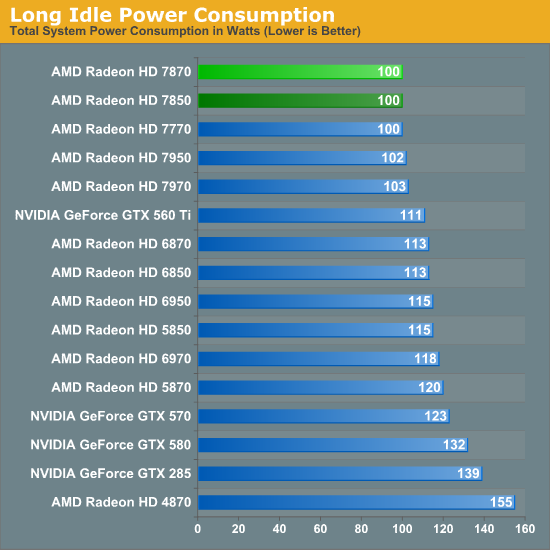
Long idle power consumption is virtually identical with the rest of the Southern Islands cards thanks to AMD’s ZeroCore Power technology. The next closest card is the GTX 560 Ti, and that’s at nearly 10W higher.
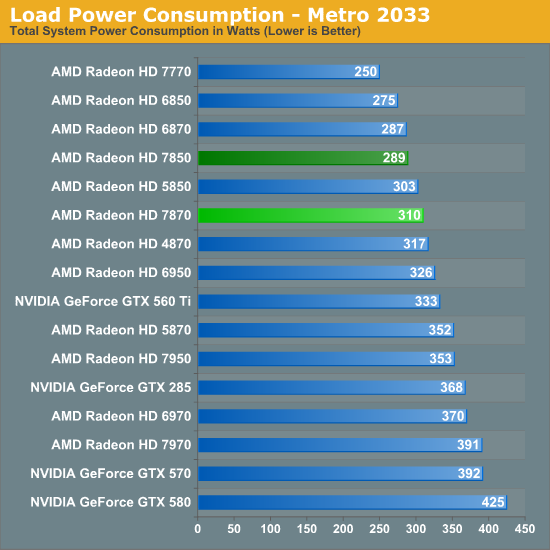
Moving on to load power testing, we have Metro 2033. Load power consumption here is about where you’d expect it to be, with the 7800 setups drawing more at the wall than the 6800 setups, but less than the 7900 and 6900 series. This is largely a consequence of performance, as the higher rendering performance of the 7800 series versus the 6800 series drives up CPU power consumption in order to generate more frames.
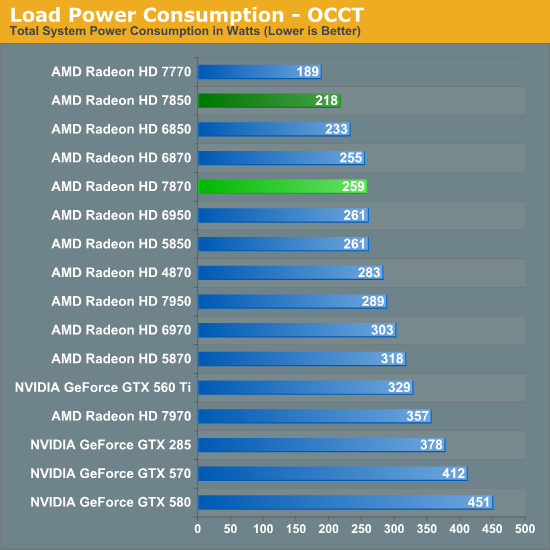
OCCT on the other hand gives us a more purified look at power consumption, and as you’d expect for 28nm it looks good. The 7870 ends up drawing only a few more watts at the wall compared to the 6870, showcasing the fact that the 7800 series is a drop-in replacement for the 6800 series from a power consumption perspective. The 7850 looks even better, capping out at 15W below the 6850, most likely as a result of PowerTune keeping the card firmly at 150W. Though it’s interesting to note that the measurements at the wall don’t perfectly align with the differences in PowerTune limits, with the 7850 drawing 30W more than the 7770 at the wall compared to a 50W PT difference, while the 7950 draws 30W more at the wall over the 7870 even though there’s only supposed to be a 10W PT difference.
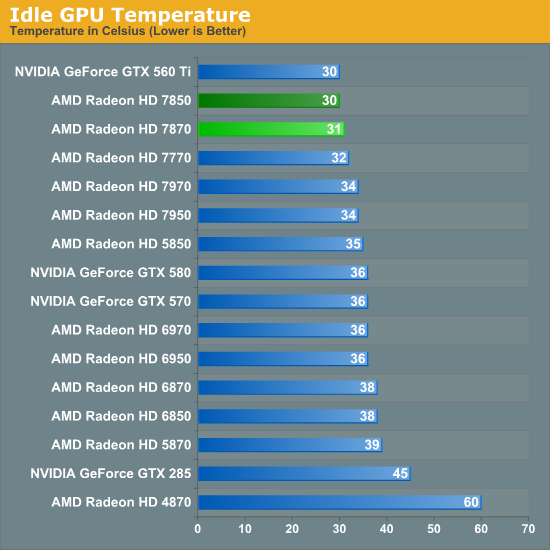
AMD’s latest generation blowers do quite well with idle temperatures and we can see it here. At 30C for the 7850 it’s every bit as cool as the GTX 560 Ti, while the entire 7800 series is around 5-8C cooler than the 6900.
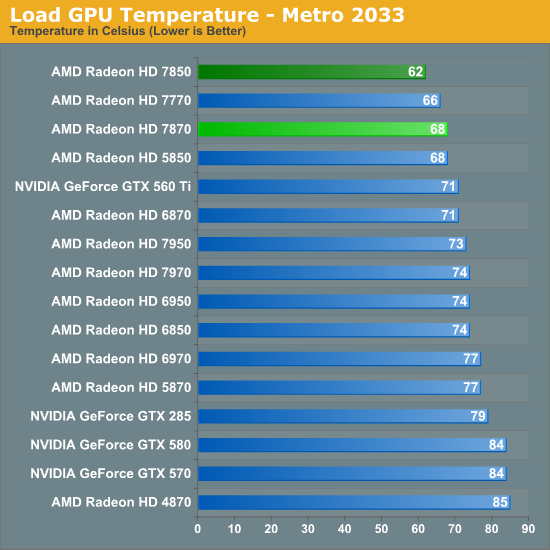
Under load, Metro temperatures are also quite good. At 62C the 7850 is the coolest card in this performance class, but keep in mind that it’s basically using an oversized cooler; retail cards will be open air coolers with much different characteristics. Otherwise at 68C the 7870 is still among the coolest cards, coming ahead of even the historically cool GTX 560 Ti, never mind the much hotter 6900 series.

Load temperatures climb under OCCT, but again the 7800 series is among the coolest temperatures we see. Here we see the 7870 peak at 73C, whereas its last generation counterpart would be at 80C and the GTX 570 at a toasty 87C.
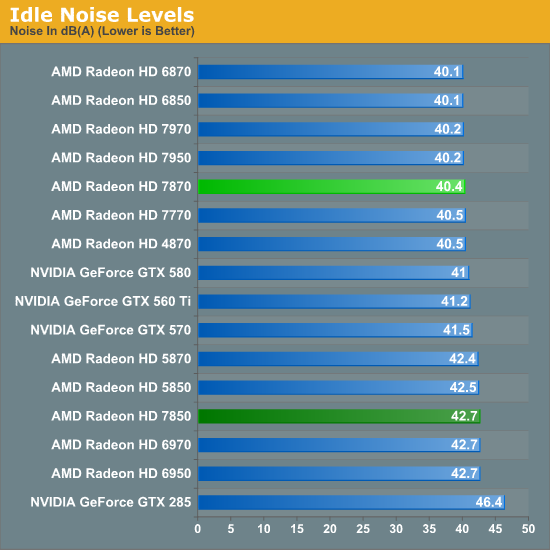
Moving on to noise testing, there are no major surprises at idle, with the 7870 hugging 40db. For whatever reason the 7850’s minimum fan state is roughly 200RPM higher than the 7870’s, but since no one will be using this cooler it’s not a significant result.
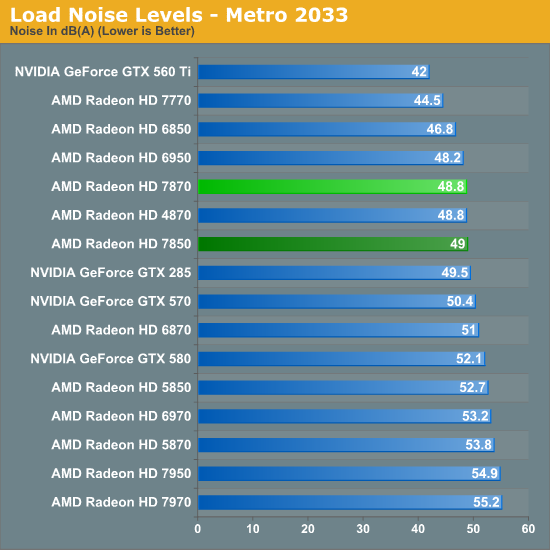
Consistent with AMD’s other 7000 series cards, we’re once again seeing the consequences of AMD’s aggressive cooling policies coupled with the use of a blower. At 48.8dB the 7870 is still quieter than the blower-based 6870, but it’s significantly louder than the open air cooled GTX 560 Ti, even though the latter consumes far more power and generates far more heat. This doesn’t make the use of a blower the wrong choice, but combined with aggressive cooling policies it does hurt AMD. The GTX 570, in spite of using much more power than the 7870, is only less than 2dB louder even though it too uses a blower.

Last, but not least we have our OCCT noise results. Unlike Metro the 7800 series does better on a relative basis here, but this is mostly because NVIDIA doesn’t have a power throttling system quite like PowerTune. At 51.9dB the 7870 is not the quietest card, but it still manages to beat the 6970 and the PowerTune-less 6870.
All things considered there are no great surprises here on a relative basis, as the 7800 series performs like we’d expect for a blower based sub-200W video card. Due to TSMC's 28nm process AMD greatly improves on their performance/power and performance/noise ratios with the 7800 series compared to the 6800 and 6900 series, while for their power class the 7800 series is slightly ahead of the pack on both power consumption and noise.
With that said, keep in mind that since most of AMD’s partners will be using open air coolers these results won’t be applicable to most retail cards. So for the temp/noise characteristics of retail cards you’ll want to look at individual card reviews when those start appearing later this month. This is particularly true for the 7950, where all of the retail cards will be using a different design than our sample.










173 Comments
View All Comments
arjuna1 - Monday, March 5, 2012 - link
Metro 2033 (the highest settings bench)Radeon 7950 33fps
Radeon 6970 27.5fps
Radeon 6870 32fps (the second highest bench)
Weee!!! $400+ for 5.5fps more.
Not sure about you, but to me, spending that kind of cash for an imperceptible increase in performance is having no sense of money's worth.
This generation of cards can safely be skipped until the 8xxx/7xx series from both AMD and NVIDIA.
Death666Angel - Tuesday, March 6, 2012 - link
Picking up one specific benchmark to underline your point. Great reasoning skills, you should join a debate team! Also, that 5.5fps is still 20%, with the good track record of overclockability, it can reach as much as 40%. But you stick to your point.arjuna1 - Tuesday, March 6, 2012 - link
What? were you expecting me to post a powerpoint presentation for just for you??The numbers are there, look at them if you want, but hey, be stuck in your point, only a frustrated basement geek can think in way to justify spending $400 +/- for less than 50% increase in performance.
Be careful of not falling of that horse, seems pretty high.
sseemaku - Tuesday, March 6, 2012 - link
Please check the avg frame rate improvements, not some specific results. But everyone agrees that 7xxx cards are a bit overpriced and that's because they don't have competition right now. If you worry about power consumption, buy these cards now. Or more interested in price/performance, wait till Kepler is released.arjuna1 - Tuesday, March 6, 2012 - link
I can agree with that, after Kepler is release prices will go down and maybe then the 7xxx series will increase in the perceived value.CeriseCogburn - Thursday, March 8, 2012 - link
If there's no competition then they aren't overpriced because they cannot be touched by anything, hence making their price absolutely correct !!!I call that "reality".
If Kepler blows their doors off, their price will fall. That's reality too.
It's time for all the amd is cheaper crud to go the way of the dinosaur.
Recently a 460 was an unbeatable value. Then a 560ti was as unbeatable value. Currently a 6870 is an unbeatable value.
These things happen, and a deal is not the general aspect of the video card prices, which generally speaking wind up right where they should be.
The deal is the exception to the usual rule across the board, and "the deal" as in "big price drop" is usually just one card here or there for a short period of time.
CeriseCogburn - Thursday, March 8, 2012 - link
Radeon cards have been coming out at $700 and $600 and $500+ for a long time man - even with competition.I don't know what planet you people come from when the constant repetition of "it sounds good" becomes an absolute meme and ongoing restated theme but in no way reflects even a tiny kernel of truth as far as reality goes.
CeriseCogburn - Friday, March 9, 2012 - link
Yes dagamer34, Ryan praises amd for drying up their 6000 series channel with such precision. Then we get this praise - the perfect price structure by AMD, and "it's conservative pricing" according to the author even though it's $40 and $30 higher than it's Nvidia counterpart..." With AMD targeting the ~$320 570 and ~$210 560 Ti and given their conservative pricing on the rest of Southern Islands, it should come as no surprise that the 7800 series is priced equally conservatively. The 7870 will have an MSRP of $350, while the 7850 will have an MSRP of $250. With the 7800 series completing the launch of Southern Islands, this gives AMD a consistent price structure for the entire family: $550, $450, $350, $250, $159, and $109."
---
I see. So more expensive is conservative, and the 6 AMD price figures are perfect and consistent...
I am so sick of it...
Falkenad2 - Monday, March 5, 2012 - link
Thus far, AMD's first foray into 28nm graphics has been unimpressive. From a price/performance standpoint, the 7000 series has not given the usual incentives for upgrading that is regularly associated with the move to a new node. I hope a strong competitor from nVidia is on the way, as that would bode well for consumers such as ourselves. As it stands, the 7000 series lacks value except at the very high end, where price/performance is of little concern.Kaboose - Monday, March 5, 2012 - link
Price vs. performance is not the only factor, some people are concerned with power draw as well. Others are interested in temps, and noise. The price could use some work (come on Nvidia) but besides that the 7xxx series has been fairly impressive in regards to overclocking, power, temp, and noise.